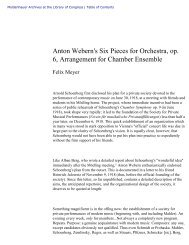Country Profile: Cuba - American Memory - Library of Congress
Country Profile: Cuba - American Memory - Library of Congress
Country Profile: Cuba - American Memory - Library of Congress
You also want an ePaper? Increase the reach of your titles
YUMPU automatically turns print PDFs into web optimized ePapers that Google loves.
<strong>Library</strong> <strong>of</strong> <strong>Congress</strong> – Federal Research Division <strong>Country</strong> <strong>Pr<strong>of</strong>ile</strong>: <strong>Cuba</strong>, September 2006<br />
As a result <strong>of</strong> a reforestation program, forests covered 21 percent <strong>of</strong> <strong>Cuba</strong>n territory by the mid-<br />
1990s, as compared with only 18 percent in 1987. By 2005, the figure had reached 24 percent,<br />
and a new reforestation program was under way with a target <strong>of</strong> increasing coverage to 29<br />
percent by 2015. The forestry programs expand the tree-covered area by 50,000 hectares each<br />
year. In comparison, the tree-covered area is expanded by less than 20,000 hectares per year<br />
when logging is used. Roundwood production in 2000 amounted to 3.3 million cubic meters and<br />
sawn wood to 146,000 cubic meters. Official <strong>Cuba</strong>n figures show that the country’s forests in<br />
2006 held more than 130 million cubic meters <strong>of</strong> usable lumber and had the potential to grow 7.5<br />
million cubic meters annually. However, reforestation in general has suffered from funding and<br />
other resource shortages since the 1990s.<br />
Although <strong>Cuba</strong>’s annual fish catch was approximately 130,000 tons before the economic crisis <strong>of</strong><br />
the 1990s, the total dropped by about two-thirds between 1990 and 1994 as a result <strong>of</strong> a lack <strong>of</strong><br />
investment, fuel, and operating capital, and the fishing industry has yet to recover. There had<br />
been some potential for making up part <strong>of</strong> the shortfall in the 1990s by developing fish farming.<br />
By 1998 the fisheries <strong>of</strong> <strong>Cuba</strong>’s man-made reservoirs, totaling an estimated 148,000 hectares,<br />
had become the main source <strong>of</strong> fish for domestic consumers, with production totaling more than<br />
70,000 tons, as compared with only 7,000 tons in 1980. By 2004, however, the output <strong>of</strong> fish<br />
farms and production (for export) <strong>of</strong> lobster and shrimp from coastal fisheries had shrunk to<br />
below the 1993 level (less than 20,000 tons), apparently as a result <strong>of</strong> an aging fishing fleet,<br />
increasingly expensive fuel, and fuel shortages.<br />
Mining and Minerals: Mining accounted for 1.4 percent <strong>of</strong> the gross domestic product in 2005.<br />
<strong>Cuba</strong> is now the world’s fifth-largest nickel and cobalt producer. Production <strong>of</strong> <strong>Cuba</strong>’s primary<br />
mineral, nickel, was estimated to reach about 77,000 tons in 2005, an increase <strong>of</strong> more than 6<br />
percent over 2004. The country’s mineral resources are mined mostly by Canadian, Spanish, and<br />
other European companies.<br />
<strong>Cuba</strong>n oil production is currently limited to the coastal region in the northwest <strong>of</strong> the country.<br />
<strong>Cuba</strong>’s crude is very heavy and has a high sulphur content. Nevertheless, high world oil prices<br />
have stimulated foreign interest in <strong>Cuba</strong>n territorial waters in the Gulf <strong>of</strong> Mexico. In 1999 <strong>Cuba</strong><br />
opened 112,000 square kilometers <strong>of</strong> its waters to foreign exploration. As <strong>of</strong> 2006, companies<br />
from Canada, China, India, Norway, and Spain have invested in drilling ventures in these waters.<br />
Industry and Manufacturing: Industry in general accounted for about 25 percent <strong>of</strong> gross<br />
domestic product (GDP) in 2005 and was expected to increase slightly to 26.9 percent in 2006.<br />
Industrial production growth totaled 3.3 percent in 2004 and 5.1 percent in 2005 and was<br />
forecast to reach 13 percent in 2006 and 7.8 percent in 2007. Manufacturing accounted for 15.4<br />
percent <strong>of</strong> GDP and construction for 7.0 percent in 2005. Power cuts and the contraction <strong>of</strong><br />
sugar-related industries have hampered growth in the manufacturing sector except for a few<br />
industries, such as production <strong>of</strong> nickel and steel, neither <strong>of</strong> which is dependent on the electricity<br />
grid, and construction, which has benefited from the government’s housing program and<br />
improvements to hospitals and schools. Growth in the construction sector reached 19 percent in<br />
2005. The government’s housing program that was approved in September 2005 envisaged the<br />
construction <strong>of</strong> 150,000 new homes by the end <strong>of</strong> 2006 and an additional 100,000 in 2007,<br />
representing the fastest pace <strong>of</strong> building since 1959. The actual totals may be somewhat lower.<br />
13



![Albert Einstein Papers [finding aid]. Library of Congress. [PDF ...](https://img.yumpu.com/21604228/1/190x245/albert-einstein-papers-finding-aid-library-of-congress-pdf-.jpg?quality=85)





![American Colony in Jerusalem Collection [finding aid]. Library of ...](https://img.yumpu.com/17941275/1/190x245/american-colony-in-jerusalem-collection-finding-aid-library-of-.jpg?quality=85)



![Piccard Family Papers [finding aid]. - American Memory - Library of ...](https://img.yumpu.com/17941234/1/190x245/piccard-family-papers-finding-aid-american-memory-library-of-.jpg?quality=85)


